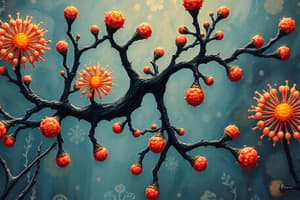Podcast
Questions and Answers
Which of the following is considered a key property shared by all living organisms?
Which of the following is considered a key property shared by all living organisms?
- Photosynthesis
- Complexity
- Mobility
- Homeostasis (correct)
What is the primary function of DNA in living organisms?
What is the primary function of DNA in living organisms?
- Regulating body temperature
- Energy production
- Storage and processing of nutrients
- Carrying genetic instructions for growth and development (correct)
Which of the following elements is NOT considered one of the four most common elements found in living organisms?
Which of the following elements is NOT considered one of the four most common elements found in living organisms?
- Carbon
- Calcium (correct)
- Oxygen
- Nitrogen
What process describes the movement of bacteria toward a chemical source?
What process describes the movement of bacteria toward a chemical source?
How do multicellular organisms reproduce?
How do multicellular organisms reproduce?
Which of the following best describes the organization level seen in multicellular organisms?
Which of the following best describes the organization level seen in multicellular organisms?
What does the term 'sensitivity to stimuli' refer to in biology?
What does the term 'sensitivity to stimuli' refer to in biology?
What are the primary biological molecules formed by carbon, hydrogen, nitrogen, oxygen, sulfur, and phosphorus?
What are the primary biological molecules formed by carbon, hydrogen, nitrogen, oxygen, sulfur, and phosphorus?
What is the primary function of the protein type, "Transport"?
What is the primary function of the protein type, "Transport"?
What process creates a polymer by joining monomers together with the release of a water molecule?
What process creates a polymer by joining monomers together with the release of a water molecule?
Which of the following is NOT a characteristic of homeostasis?
Which of the following is NOT a characteristic of homeostasis?
Which of the following is a correct example of an organism using energy processing?
Which of the following is a correct example of an organism using energy processing?
What is the correct order of biological organization, from smallest to largest?
What is the correct order of biological organization, from smallest to largest?
Which type of macromolecule is responsible for providing structural support in the cytoskeleton?
Which type of macromolecule is responsible for providing structural support in the cytoskeleton?
Which of the following organisms uses fur as a method of thermoregulation?
Which of the following organisms uses fur as a method of thermoregulation?
What type of protein is responsible for breaking down food into monomers?
What type of protein is responsible for breaking down food into monomers?
Flashcards
Homeostasis
Homeostasis
The ability of an organism to maintain a stable internal environment, even when external conditions change.
Energy Processing
Energy Processing
The process by which organisms use energy for their metabolic activities.
Dehydration Synthesis
Dehydration Synthesis
The process of building larger molecules from smaller monomers by removing water molecules.
Hydrolysis
Hydrolysis
The process of breaking down larger polymers into smaller monomers by adding water molecules.
Signup and view all the flashcards
Carbohydrates
Carbohydrates
A class of macromolecules that includes sugars, starches, and cellulose. They provide energy and structural support.
Signup and view all the flashcards
Lipids
Lipids
A class of macromolecules that includes fats, oils, and waxes. They provide energy storage, insulation, and cell membrane structure.
Signup and view all the flashcards
Proteins
Proteins
A class of macromolecules that includes proteins, enzymes, and hormones. They have diverse functions like building structures, catalysing reactions, and transporting molecules.
Signup and view all the flashcards
Nucleic Acids
Nucleic Acids
A class of macromolecules that includes DNA and RNA. They store and transmit genetic information.
Signup and view all the flashcards
What is Biology?
What is Biology?
The study of living organisms and their interactions with each other and their environment. It encompasses the science of life.
Signup and view all the flashcards
Order in Living Organisms
Order in Living Organisms
A highly organized system where atoms form molecules, molecules create organelles, cells form tissues, tissues collaborate to form organs, and organs work together to form systems.
Signup and view all the flashcards
Sensitivity to Stimuli
Sensitivity to Stimuli
The ability of organisms to respond to changes in their environment, like light, chemicals, or touch.
Signup and view all the flashcards
Reproduction
Reproduction
The process where organisms produce offspring, ensuring the continuation of their species. It involves passing on genetic information from parents.
Signup and view all the flashcards
Growth and Development
Growth and Development
The process of increasing in size and complexity. Instructions for growth are encoded within DNA, ensuring proper development.
Signup and view all the flashcards
Adaptation
Adaptation
The ability of organisms to change over time to better suit their environment. These changes can lead to adaptation.
Signup and view all the flashcardsStudy Notes
Introduction to Biology
- Biology is the study of living organisms and their interactions with each other and their environment.
- Living organisms share key properties including order, response to stimuli, reproduction, growth and development, regulation, homeostasis, energy processing, and adaptation.
- The chemical foundation of life is based on elements like carbon, hydrogen, oxygen, nitrogen, sulfur and phosphorus. These elements form the building blocks of proteins, carbohydrates, lipids and nucleic acids.
- The percentages of these elements differ in humans compared to the atmosphere and the Earth's crust.
Levels of Organization
- Matter (including living things) is composed of elements in various combinations
- Atoms, molecules, cells, tissues, organs, body systems, organisms, populations, communities, ecosystems, biosphere
Biological Macromolecules
- Organisms obtain nutrients from food.
- Large molecules (macromolecules) are polymers built from monomers (smaller units).
- The four major categories of macromolecules are carbohydrates, lipids, proteins, and nucleic acids.
Key Biological Processes
- Order: Organisms are highly organized at all levels.
- Sensitivity to stimuli: Organisms respond to stimuli in their environment.
- Reproduction: Organisms duplicate and pass their genes to offspring.
- Growth and development: Organisms grow and develop according to instructions from their DNA.
- Regulation: Organisms maintain internal stability.
- Homeostasis: The ability to maintain internal conditions.
- Energy processing: Organisms capture and use energy to perform life functions.
Additional Details
- Homeostasis: Organisms maintain constant internal conditions (temperature, pH, etc.) despite environmental changes using various mechanisms.
- Energy processing: Organisms use energy sources for metabolic activities (e.g., plants using sunlight, animals using chemical energy).
Biological Processes - examples
- Digestive enzymes: Break down food into monomers
- Transport: Transport oxygen and nutrients
- Structural: Form cytoskeleton
- Hormones: Coordinate body functions
- Defense: Provide immunity
- Contractile: Muscle contraction
- Storage: Provide nutrients for development
Studying That Suits You
Use AI to generate personalized quizzes and flashcards to suit your learning preferences.
Related Documents
Description
This quiz covers the fundamental concepts of biology, including the properties of living organisms, levels of biological organization, and the significance of biological macromolecules. Understand the building blocks of life and how different elements contribute to biological processes.




